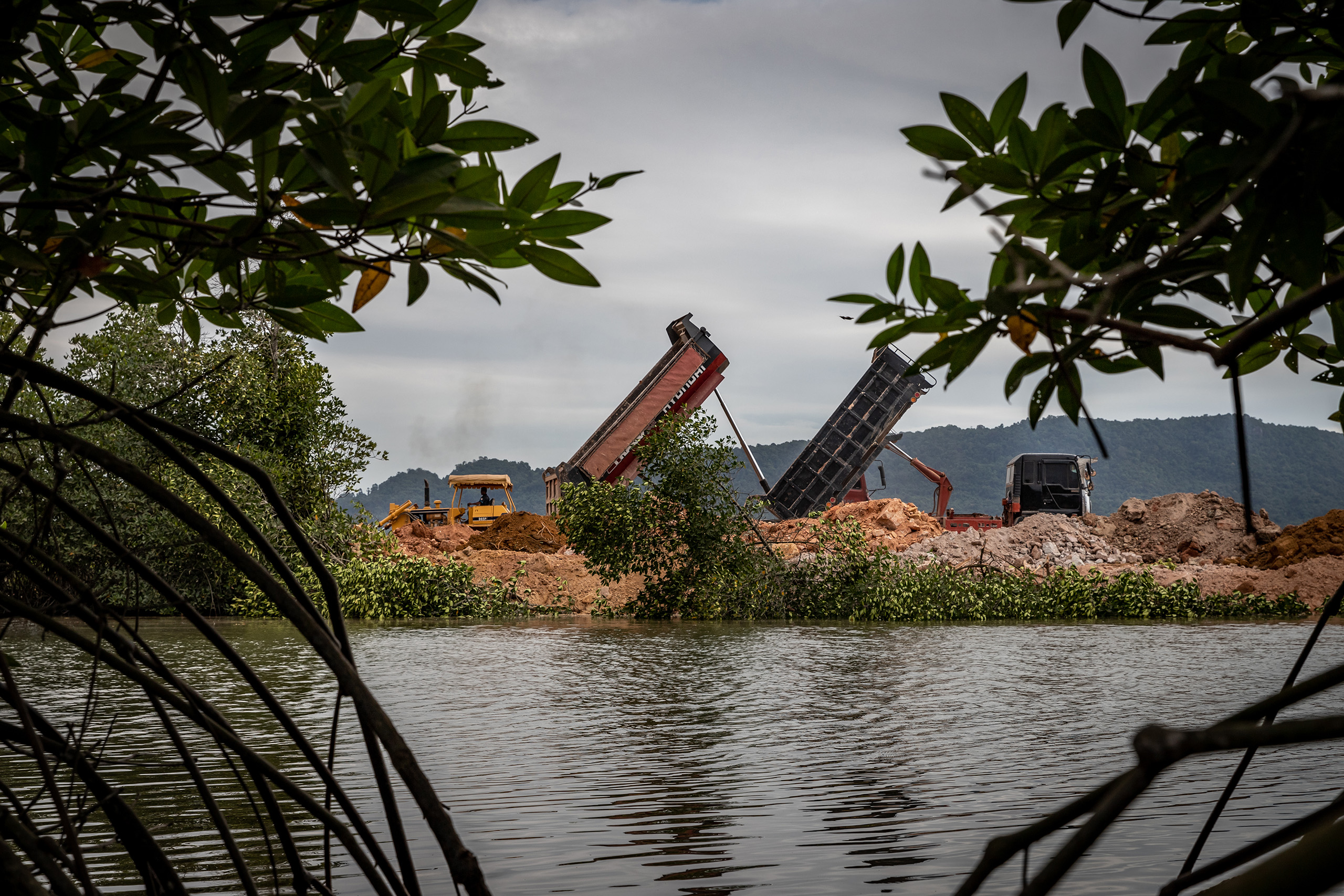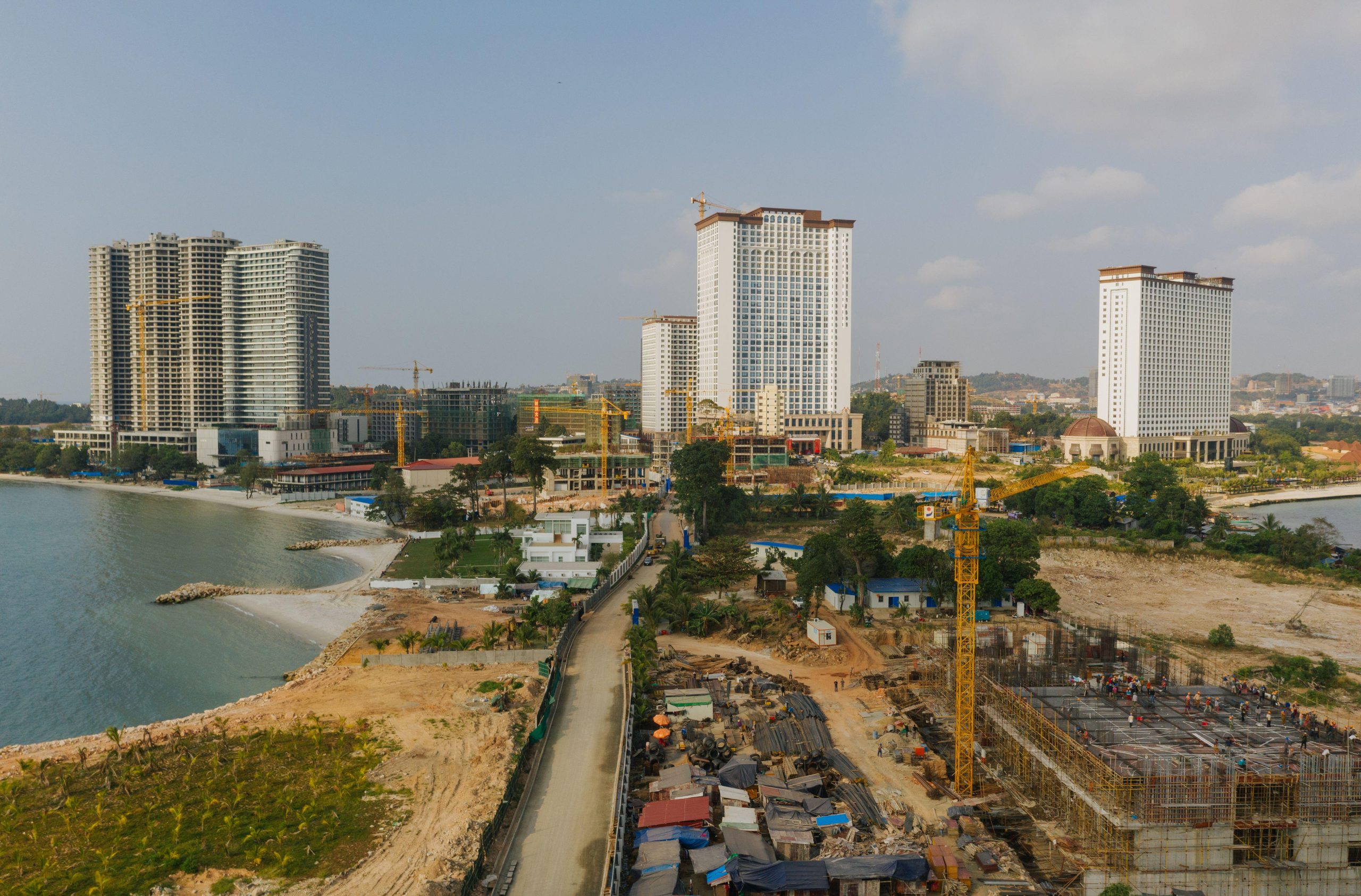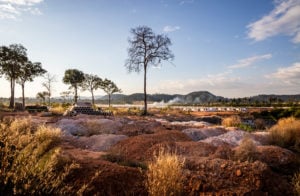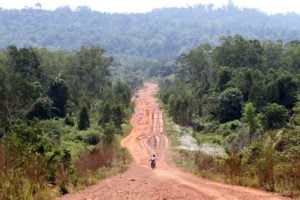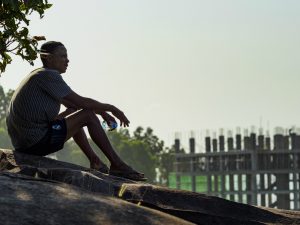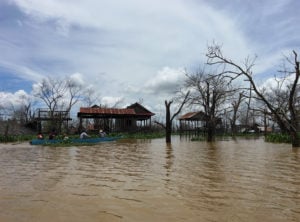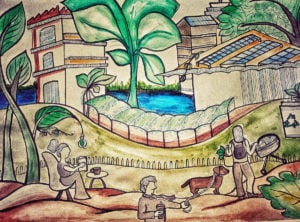San recalls how she used to earn much more before the wide new roads were built by the Cambodian government along Sihanoukville’s beaches. Her job, selling papaya salad and seafood fried noodles along the seashore, has not changed. But she’s been forced to move along the coast, from just outside Sihanoukville to within Ream National Park.
“A lot of people don’t really like to come here because on the way it’s a bit quiet and the forest is a bit thick,” she says.
About four years ago, San had to leave her steady business running a shop in Ong village, Ream commune, to make way for a road along the beach. This was as neighbouring Sihanoukville exploded with casinos and expansive resorts targeting mainly Chinese holidaymakers.
When we visited her, on a Thursday at sunset in Cambodia’s hot season, there were more vendors like San than visitors. This beach only became accessible after developers and the Cambodian navy had deforested part of the national park.
“There is nothing I can do about it,” San says. “When they told us to move, we moved. I found a new place to make money. I’m not sure about this new place’s future.”
Ream National Park, and the mangrove forests and beaches that surround it, attracted private and public developers because of its natural beauty and proximity to Sihanoukville. Residents and wildlife have suffered from tourism developments and expanding ports, but some of that natural beauty survives.
The forest held promise as a conservation zone in the early 2000s. Experts identified dozens of rare species of birds, mammals and marine creatures that relied on the system of jungles, estuaries and coasts. They noted its potential as an ecotourism area. Shortly after these assessments began, the national park was parcelled into massive land concessions spanning thousands of hectares.
As the Cambodian government finished new roads along Sihanoukville’s beaches, developments on the outskirts accelerated. These included extensive sand filling along the Ream commune’s beach to create a new gated community atop a filled-in mangrove forest. Though there’s little room for conservation projects in the national park in between the massive private concessions, conservationists hope some of the surrounding natural features can be protected to sustain species.
‘We live based on the environment around us’
In 2015, a Cambodian fishing cat was spotted on camera traps in Ream National Park. A survey of six protected areas found two cats. Since 2008, the cats’ habitat has overlapped with developers’ plans to build ostentatious resorts – 3,300 hectares in the south, for Chinese investment firm Yeejia Tourism Development, and 2,377 hectares directly north of Yeejia for Lixin Group, led by Hsu Ming-Chao of Taiwan and a nephew of Prime Minister Hun Sen, named Hun To, who is alleged to have links to the drug trade in Australia. A third company, Zhongqi Overseas Group, was granted 135 hectares on the national park’s western side, where it built rows of identical and seemingly empty vacation villas.
Vanessa Herranz Muñoz is principal investigator for the Cambodian Fishing Cat Project, an initiative to protect the species and their main habitat, mangrove forests. She says that even though the fishing cat survey found evidence that at least some cats could survive in concessions, conservation work in Ream National Park would be challenging.
“When we found fishing cats in Peam Krasop [Wildlife Sanctuary in Koh Kong province] and Ream, I checked what was going to be the future of Ream. I realised that pretty much the entire area was covered by economic land concessions that have already been allocated,” she says. “So I could only start a very small project and there’s no way I could work in that environment. Since then the project has focused on the Peam Krasop sanctuary, where they’ve carried out research on the cats while raising awareness among residents and with the environment ministry.
In the 2000s and early 2010s, several biological surveys charted the rich biodiversity of Ream National Park. Birdlife International Cambodia named the river that flows through the park an “important bird area”. Then a 2013 report by the now-defunct conservation NGO Frontier documented 125 species of birds, 30 mammals and 12 amphibians.
Conservation initiatives in the national park have since faded away. A representative for Naturelife Cambodia, the successor of Birdlife, said in a message that the NGO no longer has any projects there. The 2015 cat survey recommended developers reassess their plans in the national park in light of the fishing cat sighting, at least assessing how to mitigate damage, but Muñoz says she is not aware of further conservation efforts in the area.
Meanwhile, deforestation has increased in Ream National Park. The protected area lost 5,490 hectares of forest between 2001 and 2021, according to the satellite mapping service Global Forest Watch. That’s the equivalent of about 7,700 football fields. Just under half of this tree loss occurred in 2018 and 2019 – the height of Sihanoukville’s development.
Most recently, the Cambodian government granted another 187 hectares of state land in Prey Nob district to the National Defense Ministry to build air defence and radar facilities, according to an August 2022 decision that was publicly released in March. The area – a mountainside in between the Ream Naval Base and Canopy Sands’ extensive land reclamation project – was intact forest before excavators began digging in.
Beachside vendor San says she is able to stay for now because her husband, Rithy*, works for the Cambodian navy.
While tending to the sole customer at sunset, Rithy, who asked not to use his real name to avoid repercussions from his employer, says that the land beside this beach used to be jungle. “A lot of wild animals lived here about eight years ago, but now I rarely see them.”
His state job, paying 1,400,000 riel (US$350) per month, is not enough to cover his family’s expenses, but Rithy feels cornered.
“They let those people develop these places but then they chase out the poor, and put the money into their own pockets,” he says. “I’m not rich, we live based on the environment around us, but I don’t know how long I can keep doing this.”
Developing any unclaimed space
The stretch of Ream commune that connects the national park to the east and Sihanoukville’s mountains and beaches is rapidly being developed by private investors and the Cambodian navy.
At about the same time that the site of San’s shop was being turned into a road, the Cambodian government granted 834 hectares of coastal sea to Canopy Sands, a subsidiary of the Prince Group which is chaired by Chen Zhi, a Chinese national granted citizenship – and land ownership rights – in 2019 and 2020.
Dredgers have now filled roughly 1.5 square kilometres with sand, according to calculations based on imagery from Europe’s Sentinel-2 satellite, with signs promising condo sales and a business park. Across the road from the development, a handful of mangrove skeletons still stand in what used to be a mangrove-filled wetland according to satellite imagery and long-term residents.
A sanctuary left for fishing cats?
Though the mangroves in Ream National Park and the coasts to the west are mostly now remembered in biodiversity studies, the eastern coasts remain intact.
Muñoz said she caught camera trap footage of another fishing cat along a stretch of coast directly east of Ream National Park in 2021. Since then, she’s enlisted the help of a few volunteers to monitor the cameras and report any signs of forest destruction or hunting traps.
They’re losing a lot of habitat but they manage to hide in really, really remote areasVanessa Herranz Muñoz, principal investigator for the Cambodian Fishing Cat Project
She says in theory mangroves like these should be protected under Cambodian law because coasts are automatically state land, but in practice powerful individuals often seek to control these areas for development or land creation. However, if the mangroves are kept intact, Muñoz imagines the area could be a prime candidate for a carbon offset project.
A carbon offset project attempts to remove or avoid greenhouse gas emissions.
A project developer sets up a project that removes emissions, such as by tree planting, or avoids future emissions. The project is then evaluated by an independent body.
Once certified, carbon offset credits equivalent to the amount of CO2 avoided or removed are issued to the project. One offset credit usually represents one tonne of CO2 equivalent.
The developer then sells the offset credits to companies, governments or individuals, usually via an exchange or broker.
Muñoz warned that the rice fields behind the Prey Nob district mangroves will be susceptible to the looming impacts of sea level rise on coastal Southeast Asia, so expanding the mangrove forest further inland and protecting the area could be the best way forward.
“There’s little else you can do with those areas, whereas if you conserve them and restore those mangroves, so much benefit can come down the line.”
Studies show mangrove areas absorb more carbon than tropical forest of equal size. With fishing cats as a flagship species, Muñoz says a carbon credit project would be attractive to both donors and tourists eager to support a cute wild animal.
Muñoz noted that in general fishing cats are resilient, changing their diets and territories to survive habitat loss.
“They’re losing a lot of habitat but they manage to hide in really, really remote areas,” she says.
She noted that one was recently spotted in the flooded forests of Cambodia’s Tonle Sap Lake, despite the wide belief that they had disappeared from the area years ago. Do they remain in Ream? “It’s entirely possible,” she says, but Muñoz has no current plans to conserve the national park, nor knows of anyone who does.
“Maybe now in the near future… it’s possible to try again, but in the past it seemed like a waste of effort.”
